Analysis of Future Meteorological Drought Changes in the Yellow River Basin under Climate Change
Abstract
:1. Introduction
2. Materials and Methods
2.1. Study Area and Data Description
2.2. Methodology
2.2.1. Data Bias Correction
2.2.2. Drought Index
- (1)
- The water vapor balance between monthly precipitation and potential evapotranspiration was calculated as:where i is the ith month, and is the precipitation of ith month. is the monthly potential evapotranspiration, which was calculated by the Hargreaves formula:
- (2)
- The three-parameter log-logistic probability distribution function was employed to calculate the probability density function f(x) of the monthly precipitation series and then obtain its probability distribution function F(x):
2.2.3. Drought Identification
3. Results
3.1. Dataset Filtering
3.2. The Projection of Future Precipitation
3.3. Implications for Future Drought Changes
3.3.1. Drought Tendency
3.3.2. Drought Frequency
3.3.3. Drought Duration and Intensity
4. Discussion
5. Conclusions
- (1)
- The GCMs from CMIP6 after bias correction performs better to reproduce the temporal and spatial characteristics of precipitation in the Yellow River Basin, and the phase average deviation of temporal and spatial scales is less than 2% and 6%, respectively. The precipitation in the Yellow River Basin would increase in the future period, and the precipitation growth trend in SSP585 scenario is the most significant with the rate of 1.5 mm/a.
- (2)
- Under the SSP126 scenario, the meteorological drought in the Yellow River Basin showed a gradually increasing trend. Although the drought trend showed a weakening trend under the SSP245 and SSP585 scenarios, their drought intensity will increase more significantly than SSP126. It is necessary to prevent the occurrence of extreme drought events in the future.
- (2)
- The spatial variation of meteorological drought is heterogeneous in different emission scenarios and periods. In the middle future period of SSP126 scenario, the drought frequency of the Loess Plateau would increase significantly. Moreover, the drought tendency of the Loess Plateau would aggravate in the middle and far future of the SSP245 scenario. Besides that, the drought frequency and drought duration of the water conservation area in the upper reaches of the Yellow River might enhance obviously in the middle future of the SSP585 scenario. In addition, the drought intensity of the Loess Plateau in the Yellow River Basin in the far future period of the SSP585 scenario is the highest compared with other scenarios and periods.
Author Contributions
Funding
Institutional Review Board Statement
Informed Consent Statement
Acknowledgments
Conflicts of Interest
References
- Chiang, F.; Mazdiyasni, O.; Aghakouchak, A. Evidence of anthropogenic impacts on global drought frequency, duration, and intensity. Nat. Commun. 2021, 12, 2754. [Google Scholar] [CrossRef] [PubMed]
- Franke, J. Changing drought risks. Nat. Clim. Chang. 2022, 12, 118. [Google Scholar] [CrossRef]
- Wang, F.; Wang, Z.; Yang, H.; Zhao, Y. Study of the temporal and spatial patterns of drought in the Yellow River basin based on SPEI. Sci. China Earth Sci. 2018, 61, 1098–1111. [Google Scholar] [CrossRef]
- Zhang, H.; Ding, J.; Wang, Y.; Zhou, D.; Zhu, Q. Investigation about the correlation and propagation among meteorological, agricultural and groundwater droughts over humid and arid/semi-arid basins in China. J. Hydrol. 2021, 603, 127007. [Google Scholar] [CrossRef]
- Wang, Y.; Yang, J.; Chang, J.; Ran, Z. Assessing the drought mitigation ability of the reservoir in the downstream of the Yellow River. Sci. Total Environ. 2018, 646, 1327–1335. [Google Scholar] [CrossRef]
- Omer, A.; Zhuguo, M.; Zheng, Z.; Saleem, F. Natural and anthropogenic influences on the recent droughts in Yellow River Basin, China. Sci. Total Environ. 2020, 704, 135428. [Google Scholar] [CrossRef]
- Shen, M.; Chen, J.; Zhuan, M.; Chen, H.; Xu, C.-Y.; Xiong, L. Estimating uncertainty and its temporal variation related to global climate models in quantifying climate change impacts on hydrology. J. Hydrol. 2018, 556, 10–24. [Google Scholar] [CrossRef]
- Zheng, H.; Chiew, F.H.; Charles, S.; Podger, G. Future climate and runoff projections across South Asia from CMIP5 global climate models and hydrological modelling. J. Hydrol. Reg. Stud. 2018, 18, 92–109. [Google Scholar] [CrossRef]
- Meehl, G.A.; Senior, C.A.; Eyring, V.; Flato, G.; Lamarque, J.-F.; Stouffer, R.J.; Taylor, K.E.; Schlund, M. Context for interpreting equilibrium climate sensitivity and transient climate response from the CMIP6 Earth system models. Sci. Adv. 2020, 6, eaba1981. [Google Scholar] [CrossRef]
- Fujimori, S.; Hasegawa, T.; Masui, T.; Takahashi, K.; Herran, D.S.; Dai, H.; Hijioka, Y.; Kainuma, M. SSP3: AIM implementation of shared socioeconomic pathways. Glob. Environ. Chang. 2017, 42, 268–283. [Google Scholar] [CrossRef]
- O’Neill, B.C.; Kriegler, E.; Riahi, K.; Ebi, K.L.; Hallegatte, S.; Carter, T.R.; Mathur, R.; Vuuren, D.V. A new scenario framework for climate change research: The concept of shared socioeconomic pathways. Clim. Chang. 2013, 122, 387–400. [Google Scholar] [CrossRef] [Green Version]
- Van Vuuren, D.P.; Stehfest, E.; Gernaat, D.E.; Doelman, J.C.; Van den Berg, M.; Harmsen, M.; de Boer, H.S.; Bouwman, L.F.; Daioglou, V.; Edelenbosch, O.Y. Energy, land-use and greenhouse gas emissions trajectories under a green growth paradigm. Glob. Environ. Chang. 2017, 42, 237–250. [Google Scholar] [CrossRef] [Green Version]
- Xu, Z.; Han, Y.; Tam, C.-Y.; Yang, Z.-L.; Fu, C. Bias-corrected CMIP6 global dataset for dynamical downscaling of the historical and future climate (1979–2100). Sci. Data 2021, 8, 293. [Google Scholar] [CrossRef] [PubMed]
- Ajjur, S.B.; Al-Ghamdi, S.G. Global hotspots for future absolute temperature extremes from CMIP6 models. Earth Space Sci. 2021, 8, e2021EA001817. [Google Scholar] [CrossRef]
- Kadkhodazadeh, M.; Valikhan Anaraki, M.; Morshed-Bozorgdel, A.; Farzin, S. A new methodology for reference evapotranspiration prediction and uncertainty analysis under climate change conditions based on machine learning, multi criteria decision making and Monte Carlo methods. Sustainability 2022, 14, 2601. [Google Scholar] [CrossRef]
- Smitha, P.; Narasimhan, B.; Sudheer, K.; Annamalai, H. An improved bias correction method of daily rainfall data using a sliding window technique for climate change impact assessment. J. Hydrol. 2018, 556, 100–118. [Google Scholar] [CrossRef]
- Li, N.; Li, Y.; Yao, N. Bias correction of the observed daily precipitation and re-division of climatic zones in China. Int. J. Climatol. 2018, 38, 3369–3387. [Google Scholar] [CrossRef]
- Zhou, Z.; Shi, H.; Fu, Q.; Ding, Y.; Li, T.; Wang, Y.; Liu, S. Characteristics of propagation from meteorological drought to hydrological drought in the Pearl River Basin. J. Geophys. Res. Atmos. 2021, 126, e2020JD033959. [Google Scholar] [CrossRef]
- Wang, L.; Zhang, J.; Elmahdi, A.; Shu, Z.; Wang, G. Evolution Characteristics and Relationship of Meteorological and Hydrological Droughts from 1961 to 2018 in Hanjiang River Basin, China. J. Water Clim. Chang. 2021, 13, 224–246. [Google Scholar] [CrossRef]
- Yihdego, Y.; Vaheddoost, B.; Al-Weshah, R.A. Drought indices and indicators revisited. Arab. J. Geosci. 2019, 12, 69. [Google Scholar] [CrossRef]
- Livada, I.; Assimakopoulos, V. Spatial and temporal analysis of drought in Greece using the Standardized Precipitation Index (SPI). Theor. Appl. Climatol. 2007, 89, 143–153. [Google Scholar] [CrossRef]
- Heddinghaus, T.R.; Sabol, P. A review of the Palmer Drought Severity Index and where do we go from here. In Proc. 7th Conf. on Applied Climatology; American Meteorological Society: Boston, MA, USA, 1991; pp. 242–246. [Google Scholar]
- Vicente-Serrano, S.M.; Beguería, S.; López-Moreno, J.I. A multiscalar drought index sensitive to global warming: The standardized precipitation evapotranspiration index. J. Clim. 2010, 23, 1696–1718. [Google Scholar] [CrossRef] [Green Version]
- Beguería, S.; Vicente-Serrano, S.M.; Reig, F.; Latorre, B. Standardized precipitation evapotranspiration index (SPEI) revisited: Parameter fitting, evapotranspiration models, tools, datasets and drought monitoring. Int. J. Climatol. 2014, 34, 3001–3023. [Google Scholar] [CrossRef] [Green Version]
- Wang, T.; Tu, X.; Singh, V.P.; Chen, X.; Lin, K. Global data assessment and analysis of drought characteristics based on CMIP6. J. Hydrol. 2021, 596, 126091. [Google Scholar] [CrossRef]
- Sung, J.H.; Park, J.; Jeon, J.-J.; Seo, S.B. Assessment of Inter-Model Variability in Meteorological Drought Characteristics Using CMIP5 GCMs over South Korea. KSCE J. Civ. Eng. 2020, 24, 2824–2834. [Google Scholar] [CrossRef]
- Xu, Y.; Zhang, X.; Hao, Z.; Hao, F.; Li, C. Projections of future meteorological droughts in China under CMIP6 from a three-dimensional perspective. Agric. Water Manag. 2021, 252, 106849. [Google Scholar] [CrossRef]
- Ma, M.; Yuan, F.; Cui, H.; Ren, L.; Liu, Y. A comprehensive analysis of meteorological drought stress over the Yellow River basin (China) for the next 40 years. Int. J. Climatol. 2020, 41, E2927–E2948. [Google Scholar] [CrossRef]
- Wang, F.; Wang, Z.; Yang, H.; Di, D.; Zhao, Y.; Liang, Q.; Hussain, Z. Comprehensive evaluation of hydrological drought and its relationships with meteorological drought in the Yellow River basin, China. J. Hydrol. 2020, 584, 124751. [Google Scholar] [CrossRef]
- Lv, X.; Zuo, Z.; Ni, Y.; Sun, J.; Wang, H. The effects of climate and catchment characteristic change on streamflow in a typical tributary of the Yellow River. Sci. Rep. 2019, 9, 14535. [Google Scholar] [CrossRef] [Green Version]
- Zhang, L.; Yang, X. Applying a multi-model ensemble method for long-term runoff prediction under climate change scenarios for the Yellow River Basin, China. Water 2018, 10, 301. [Google Scholar] [CrossRef] [Green Version]
- Shu, Z.; Zhang, J.; Jin, J.; Wang, L.; Wang, G.; Wang, J.; Sun, Z.; Liu, J.; Liu, Y.; He, R. Evaluation and Application of Quantitative Precipitation Forecast Products for Mainland China Based on TIGGE Multimodel Data. J. Hydrometeorol. 2021, 22, 1199–1219. [Google Scholar] [CrossRef]
- Wang, L.; Zhang, J.; Shu, Z.; Wang, Y.; Bao, Z.; Liu, C.; Zhou, X.; Wang, G. Evaluation of the ability of CMIP6 global climate models to simulate precipitation in the Yellow River Basin, China. Front. Earth Sci. 2022, 9, 744462190. [Google Scholar] [CrossRef]
- Chadwick, C.; Gironás, J.; Vicuña, S.; Meza, F.; McPhee, J. Using a statistical preanalysis approach as an ensemble technique for the unbiased mapping of GCM changes to local stations. J. Hydrometeorol. 2018, 19, 1447–1465. [Google Scholar] [CrossRef]
- Try, S.; Tanaka, S.; Tanaka, K.; Sayama, T.; Khujanazarov, T.; Oeurng, C. Comparison of CMIP5 and CMIP6 GCM performance for flood projections in the Mekong River Basin. J. Hydrol. Reg. Stud. 2022, 40, 101035. [Google Scholar] [CrossRef]
- Panjwani, S.; Naresh Kumar, S.; Ahuja, L. Bias correction of gcm data using quantile mapping technique. In Proceedings of International Conference on Communication and Computational Technologies; Springer: Singapore, 2021; pp. 617–621. [Google Scholar]
- Frei, A.; Mukundan, R.; Chen, J.; Gelda, R.K.; Owens, E.M.; Gass, J.; Ravindranath, A. A cascading bias correction method for global climate model simulated multi-year precipitation variability. J. Hydrometeorol. 2022, 23, 697–713. [Google Scholar] [CrossRef]
- Liu, C.; Yang, C.; Yang, Q.; Wang, J. Spatiotemporal drought analysis by the standardized precipitation index (SPI) and standardized precipitation evapotranspiration index (SPEI) in Sichuan Province, China. Sci. Rep. 2021, 11, 1280. [Google Scholar] [CrossRef]
- Gurrapu, S.; Hodder, K.R.; Sauchyn, D.J.; Jacques, J.M.S. Assessment of the ability of the standardized precipitation evapotranspiration index (SPEI) to model historical streamflow in watersheds of Western Canada. Can. Water Resour. J. Rev. Can. Des Ressour. Hydr. 2021, 46, 52–72. [Google Scholar] [CrossRef]
- Zarei, A.R.; Mahmoudi, M.R. Assessment of the effect of PET calculation method on the Standardized Precipitation Evapotranspiration Index (SPEI). Arab. J. Geosci. 2020, 13, 182. [Google Scholar] [CrossRef]
- Polong, F.; Chen, H.; Sun, S.; Ongoma, V. Temporal and spatial evolution of the standard precipitation evapotranspiration index (SPEI) in the Tana River Basin, Kenya. Theor. Appl. Climatol. 2019, 138, 777–792. [Google Scholar] [CrossRef]
- Zhou, J.; Wang, Y.; Su, B.; Wang, A.; Tao, H.; Zhai, J.; Kundzewicz, Z.W.; Jiang, T. Choice of potential evapotranspiration formulas influences drought assessment: A case study in China. Atmos. Res. 2020, 242, 104979. [Google Scholar] [CrossRef]
- Yao, N.; Li, Y.; Lei, T.; Peng, L. Drought evolution, severity and trends in mainland China over 1961–2013. Sci. Total Environ. 2018, 616, 73–89. [Google Scholar] [CrossRef] [PubMed]
- Hao, Z.; Hao, F.; Singh, V.P.; Xia, Y.; Ouyang, W.; Shen, X. A theoretical drought classification method for the multivariate drought index based on distribution properties of standardized drought indices. Adv. Water Resour. 2016, 92, 240–247. [Google Scholar] [CrossRef]
- Mann, H.B. Nonparametric test against trend. Econometrica 1945, 13, 245–259. [Google Scholar] [CrossRef]
- Wang, G.; Wang, D.; Trenberth, K.E.; Erfanian, A.; Yu, M.; Bosilovich, M.G.; Parr, D.T. The peak structure and future changes of the relationships between extreme precipitation and temperature. Nat. Clim. Chang. 2017, 7, 268–274. [Google Scholar] [CrossRef]
- Pfahl, S.; O’Gorman, P.A.; Fischer, E.M. Understanding the regional pattern of projected future changes in extreme precipitation. Nat. Clim. Chang. 2017, 7, 423–427. [Google Scholar] [CrossRef]
- Zhongming, Z.; Linong, L.; Xiaona, Y.; Wangqiang, Z.; Wei, L. AR6 Climate Change 2021: The Physical Science Basis. 2021. Available online: https://www.unep.org/resources/report/climate-change-2021-physical-science-basis-working-group-i-contribution-sixth (accessed on 17 April 2022).
- Ji, G.; Lai, Z.; Yan, D.; Wu, L.; Wang, Z. Spatiotemporal patterns of future meteorological drought in the Yellow River Basin based on SPEI under RCP scenarios. Int. J. Clim. Chang. Strateg. Manag. 2021, 14, 39–53. [Google Scholar] [CrossRef]
- Wang, Y.; Wang, S.; Zhao, W.; Liu, Y. The increasing contribution of potential evapotranspiration to severe droughts in the Yellow River basin. J. Hydrol. 2022, 605, 127310. [Google Scholar] [CrossRef]
- Liu, Q. Drought variation and its sensitivity coefficients to climatic factors in the Yellow River Basin. Chin. J. Agrometeorol. 2016, 37, 623–632. [Google Scholar]
- Wu, J.; Miao, C.; Zheng, H.; Duan, Q.; Lei, X.; Li, H. Meteorological and hydrological drought on the Loess Plateau, China: Evolutionary characteristics, impact, and propagation. J. Geophys. Res. Atmos. 2018, 123, 11–569. [Google Scholar] [CrossRef]
- Ma, M.; Cui, H.; Wang, W.; Huang, X.; Tu, X. Projection of spatiotemporal patterns and possible changes of drought in the Yellow River basin, China. Theor. Appl. Climatol. 2019, 138, 1971–1989. [Google Scholar] [CrossRef]
- Park, S.Y.; Sur, C.; Kim, J.S.; Choi, S.J.; Lee, J.H.; Kim, T.W. Projected drought risk assessment from water balance perspectives in a changing climate. Int. J. Climatol. 2021, 41, 2765–2777. [Google Scholar] [CrossRef]
- Dai, A.; Zhao, T.; Chen, J. Climate change and drought: A precipitation and evaporation perspective. Curr. Clim. Chang. Rep. 2018, 4, 301–312. [Google Scholar] [CrossRef]
- Han, Z.; Huang, Q.; Huang, S.; Leng, G.; Bai, Q.; Liang, H.; Wang, L.; Zhao, J.; Fang, W. Spatial-temporal dynamics of agricultural drought in the Loess Plateau under a changing environment: Characteristics and potential influencing factors. Agric. Water Manag. 2021, 244, 106540. [Google Scholar] [CrossRef]
- Han, Z.; Huang, S.; Huang, Q.; Bai, Q.; Leng, G.; Wang, H.; Zhao, J.; Wei, X.; Zheng, X. Effects of vegetation restoration on groundwater drought in the Loess Plateau, China. J. Hydrol. 2020, 591, 125566. [Google Scholar] [CrossRef]
- Li, Y.; Xie, Z.; Qin, Y.; Xia, H.; Zheng, Z.; Zhang, L.; Pan, Z.; Liu, Z. Drought Under Global Warming and Climate Change: An Empirical Study of the Loess Plateau. Sustainability 2019, 11, 1281. [Google Scholar] [CrossRef] [Green Version]
- Shi, Y.F.; Peng, S. Spatiotemporal changes in drought across the Loess Plateau from 2018 to 2100. J. Lanzhou Univ. Nat. Sci. 2020, 56, 785–792. [Google Scholar] [CrossRef]
- Wang, M.; Fu, J.E.; Wu, Z.; Pang, Z. Spatiotemporal variation of NDVI in the vegetation growing season in the source region of the Yellow River, China. ISPRS Int. J. Geo-Inf. 2020, 9, 282. [Google Scholar] [CrossRef] [Green Version]
- Ren, Y.; Liu, J.; Shalamzari, M.J.; Arshad, A.; Liu, S.; Liu, T.; Tao, H. Monitoring Recent Changes in Drought and Wetness in the Source Region of the Yellow River Basin, China. Water 2022, 14, 861. [Google Scholar] [CrossRef]

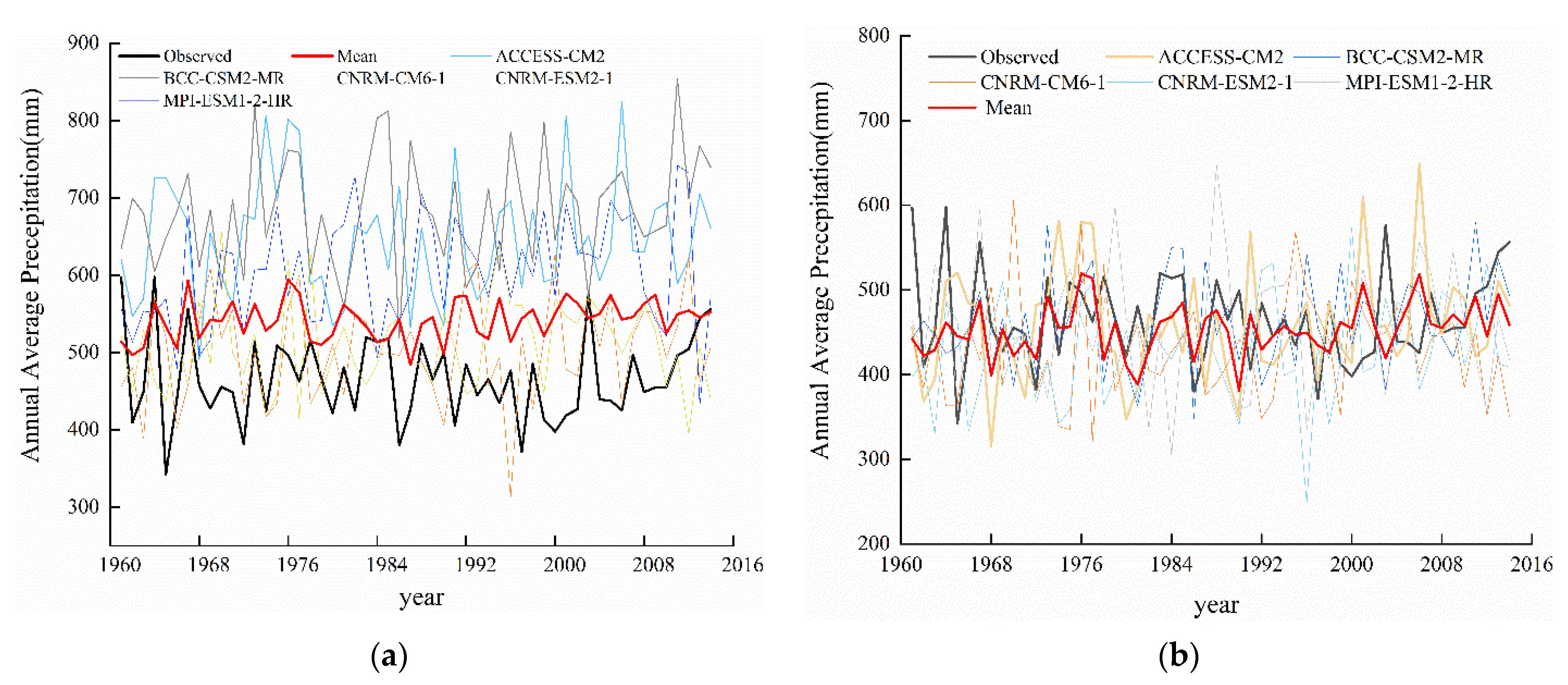

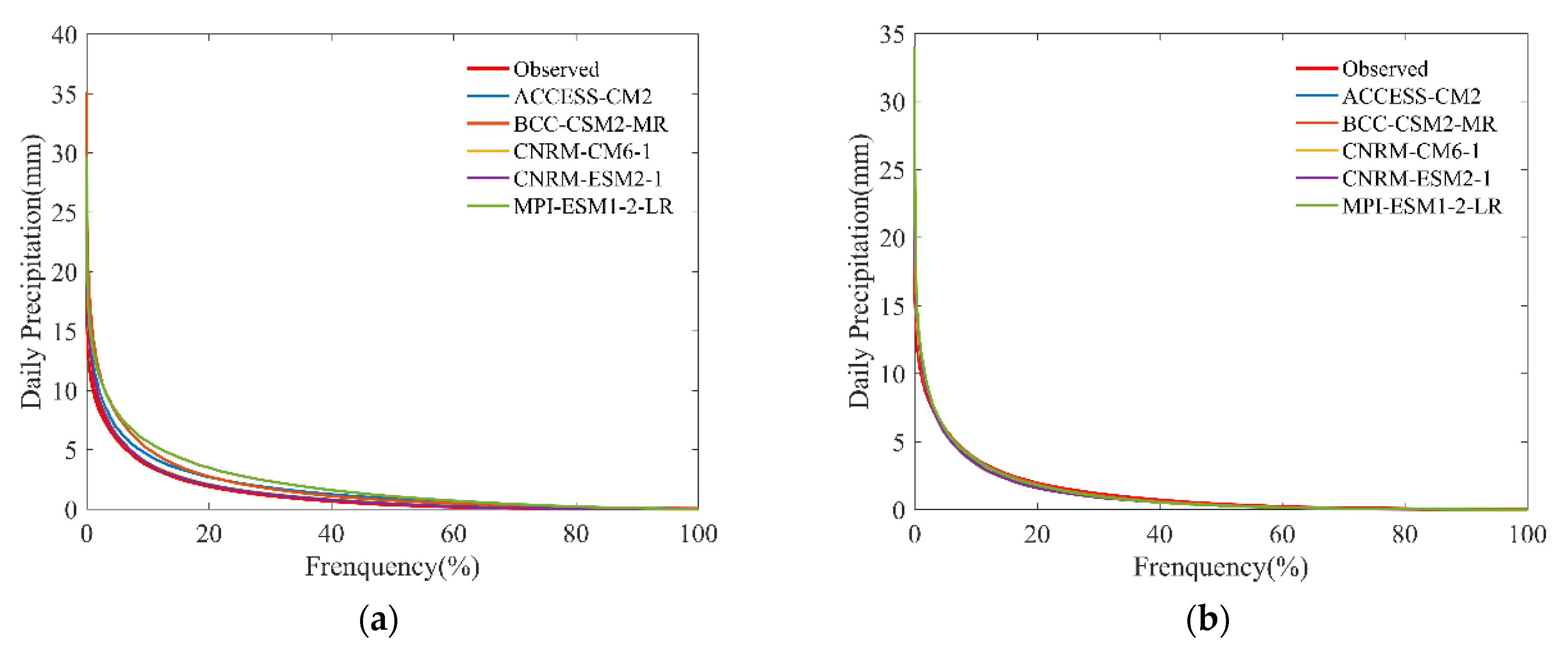
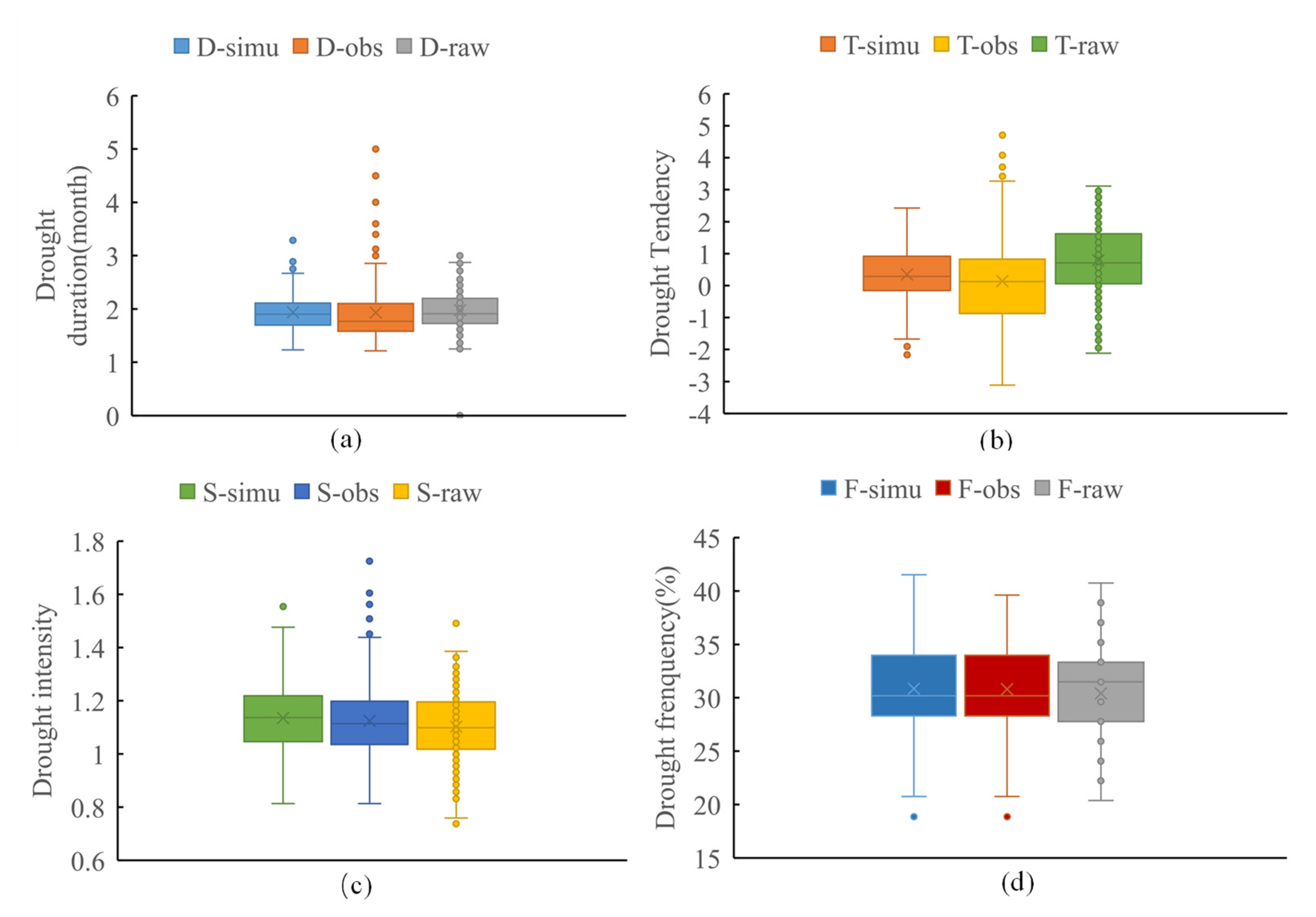

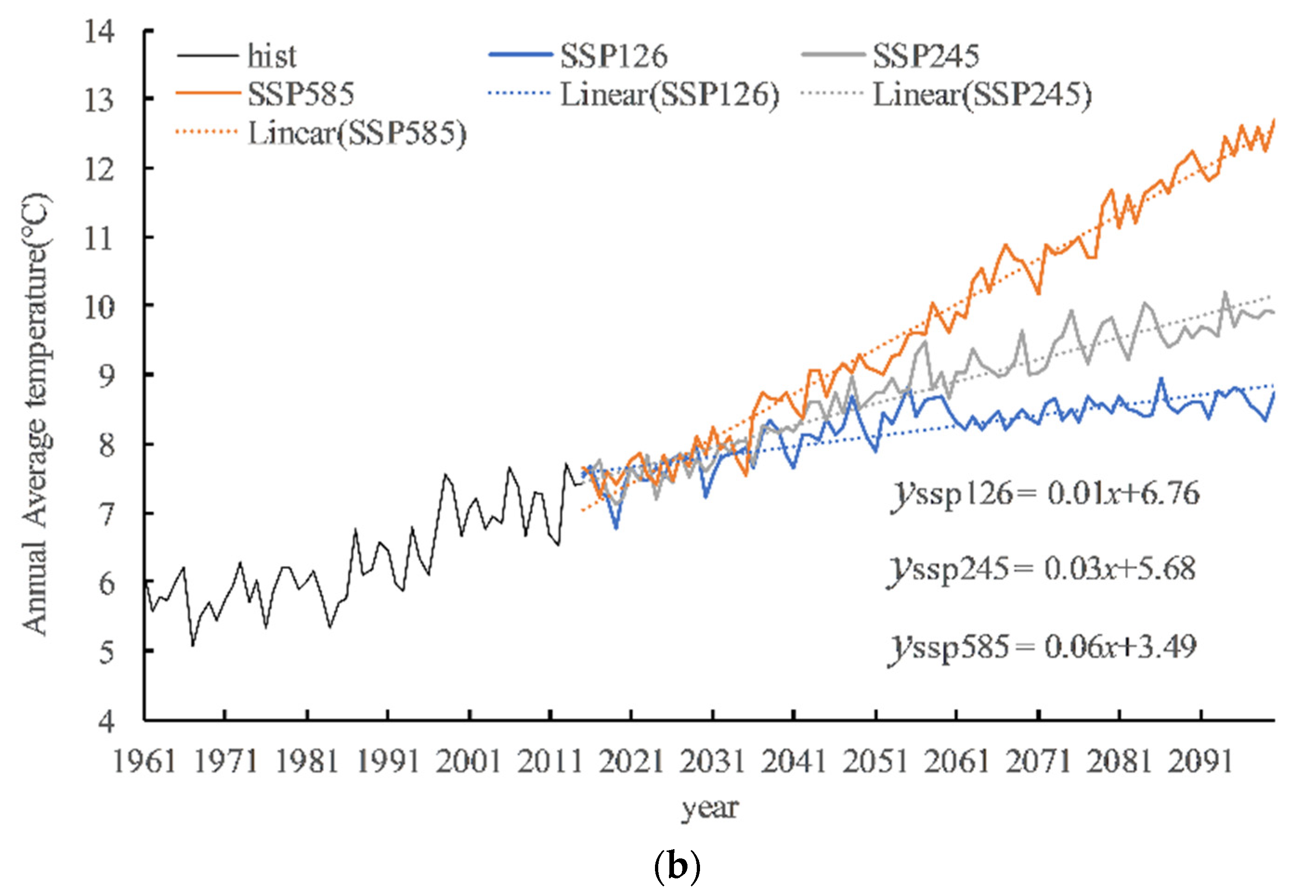
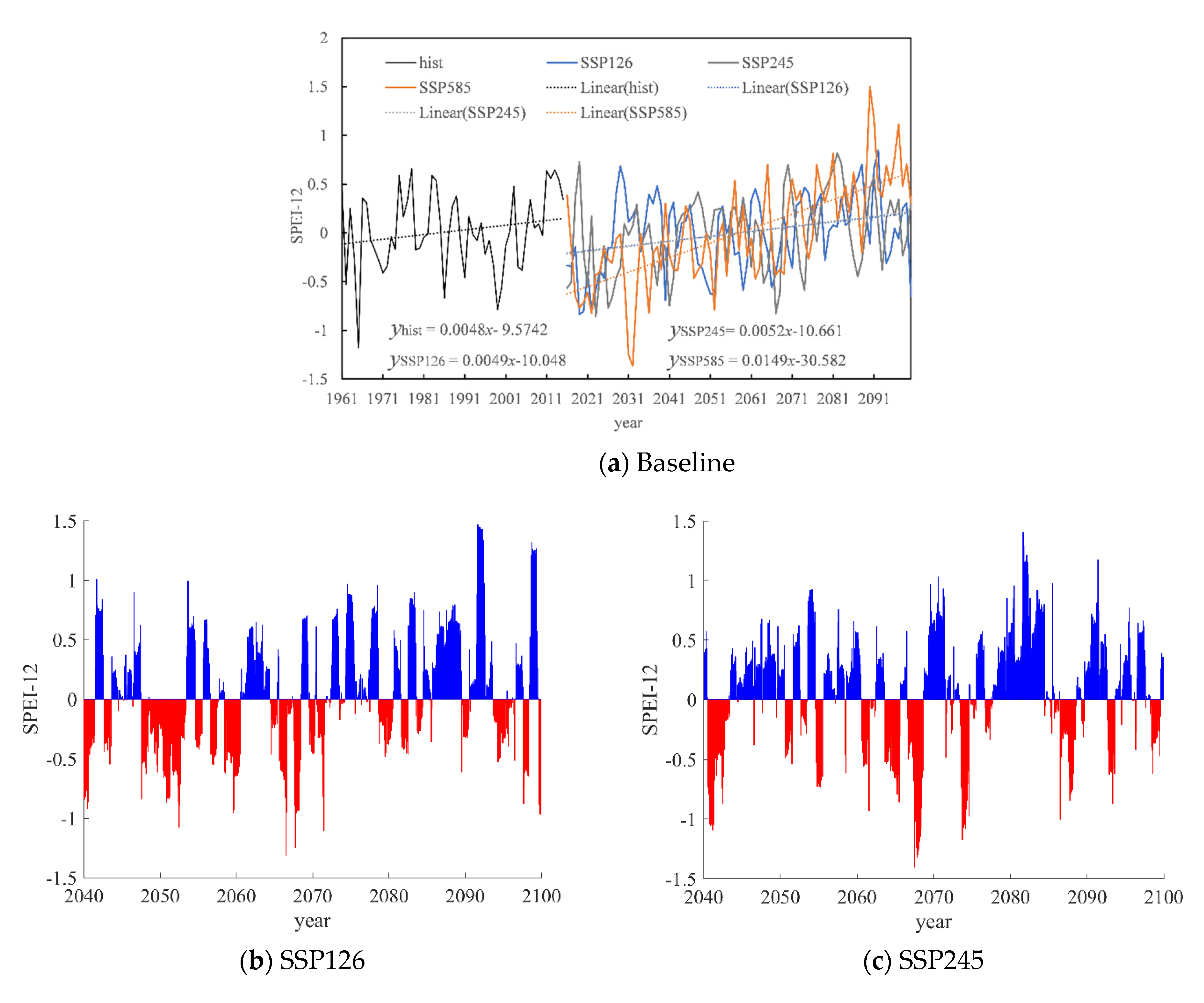
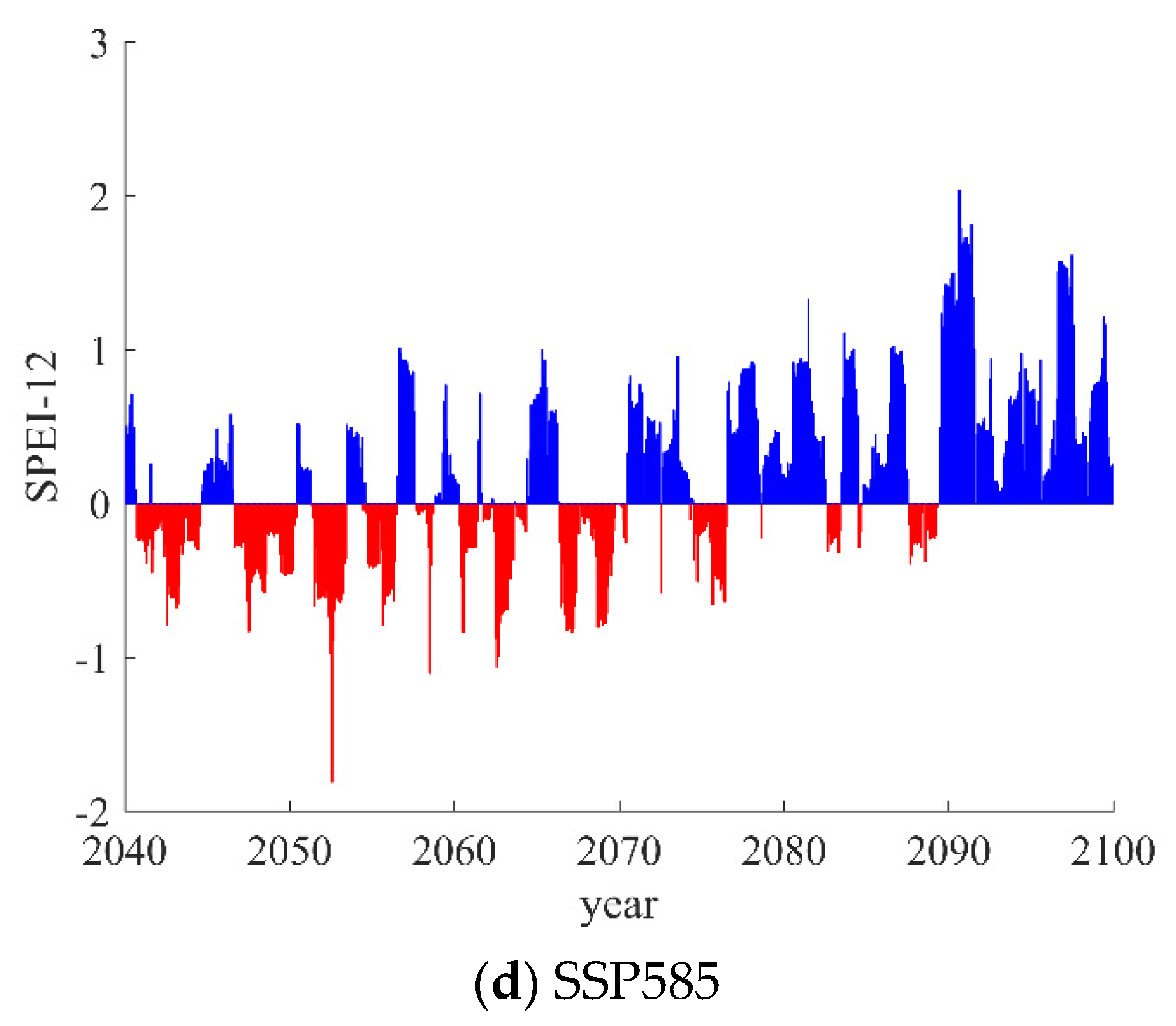
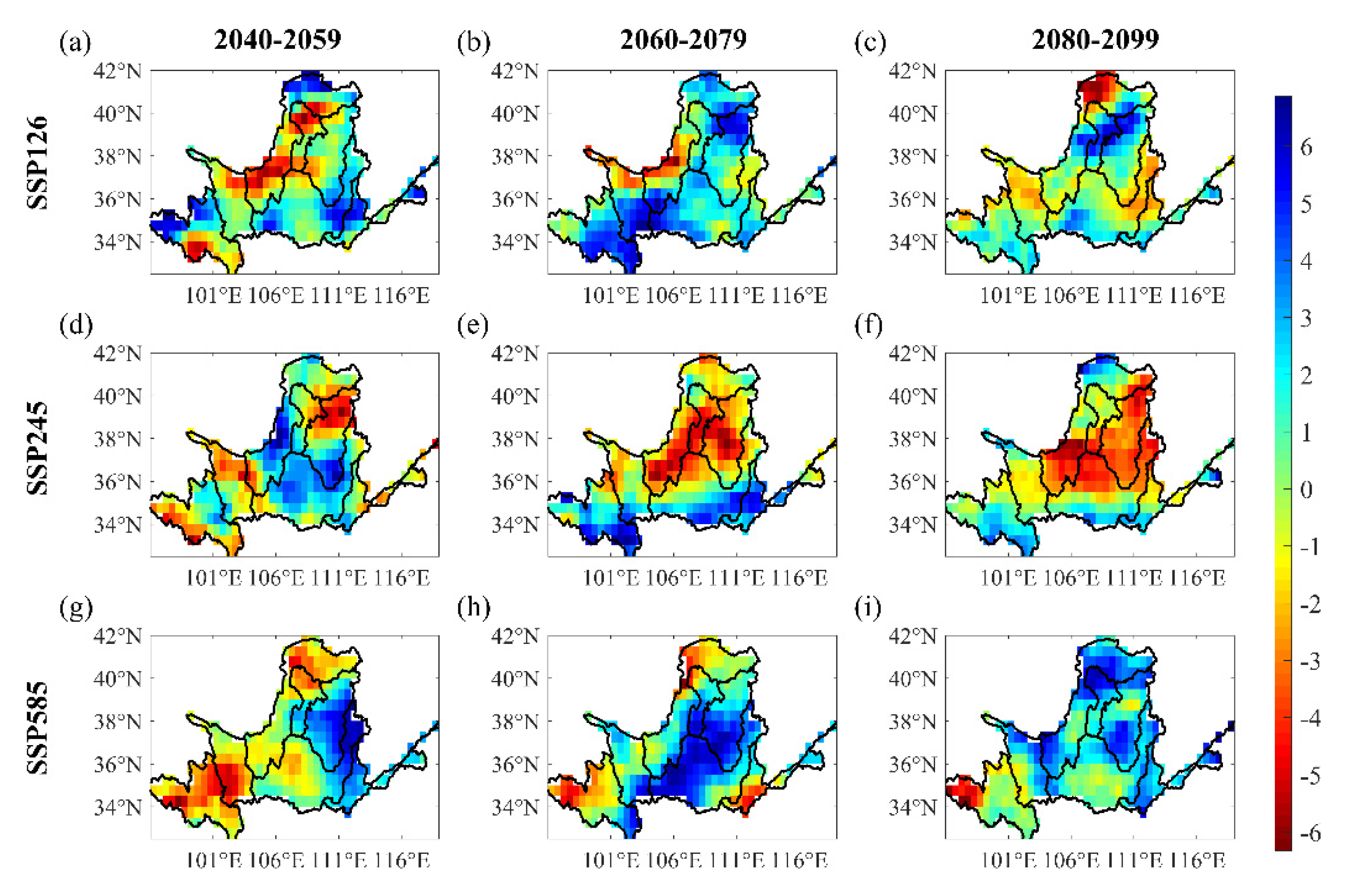

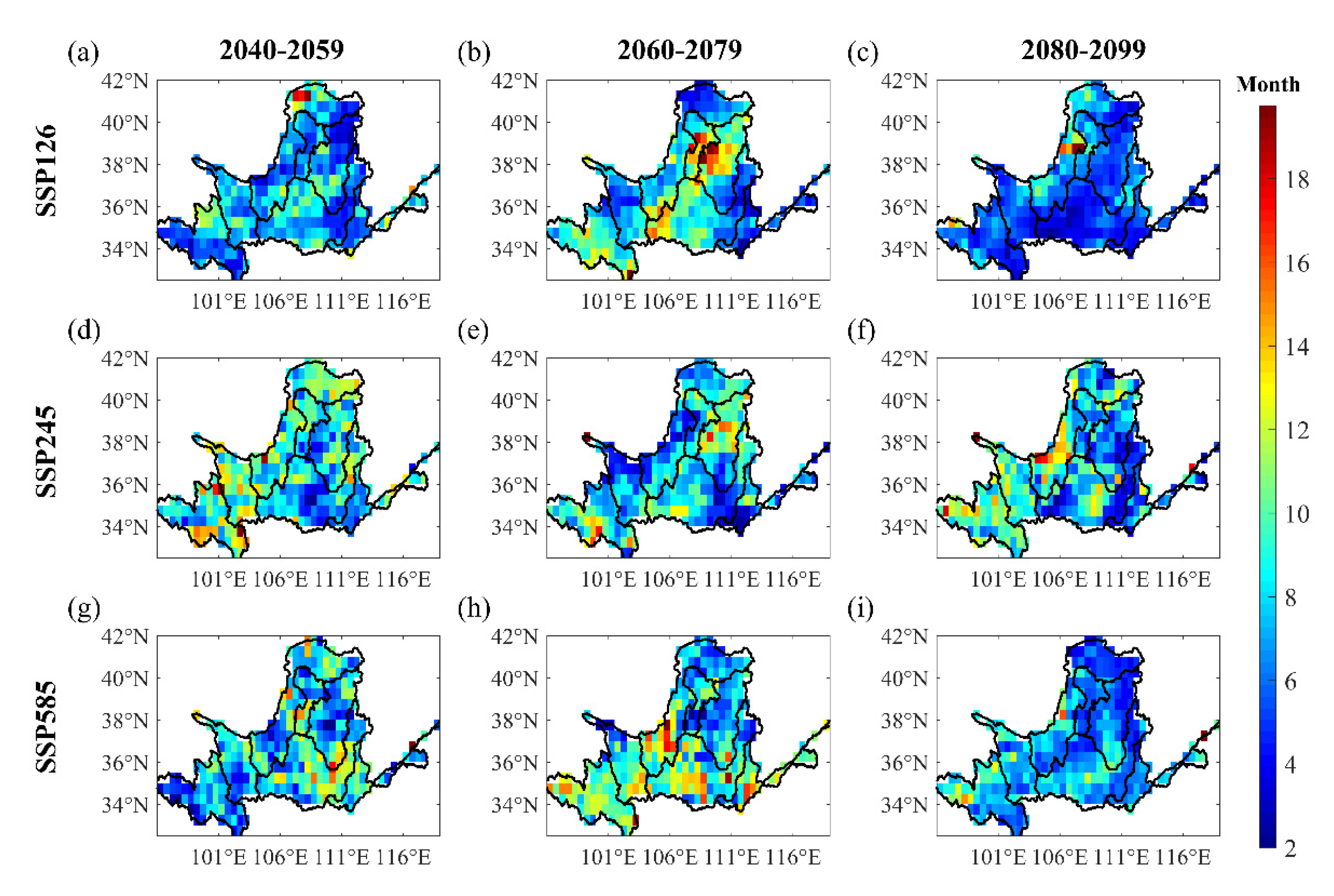

| Number | Area Range |
|---|---|
| I | Above Longyangxia |
| II | Longyangxia~Lanzhou |
| III | Lanzhou~Hekou town |
| IV | Interior region |
| V | Longmen~SanMenXia |
| VI | Hekou town~Longmen |
| VII | SanMenXia~HuaYuanKou |
| VIII | Below HuaYuanKou |
| Number | Model | Country | Atmospheric Resolution (lon × lat) |
|---|---|---|---|
| 1 | ACCESS-CM2 | Australia | 1.875° × 1.25° |
| 2 | BCC-CSM2-MR | China | 1.125° × 1.125° |
| 3 | CNRM-CM6-1 | France | 1.40625° × 1.40625° |
| 4 | CNRM-ESM2-1 | France | 1.40625° × 1.40625° |
| 5 | MPI-ESM1-2-LR | Germany | 1.875° × 1.8652° |
| SPEI | Drought Level |
|---|---|
| Light Drought | |
| Moderate Drought | |
| Severe Drought | |
| Extreme Drought |
| Duration (m) | Intensity | Tendency | Frequency (%) | |
|---|---|---|---|---|
| Baseline | 1.12 | 1.93 | 0.14 | 30.91 |
| SSP126 | 1.41 | 1.39 | −0.029 | 28.97 |
| SSP245 | 1.32 | 1.43 | 0.195 | 26.51 |
| SSP585 | 1.01 | 1.51 | 1.84 | 25.07 |
| Time | Scenarios | Light Drought | Moderate Drought | Severe Drought | Extreme Drought | Drought Frequency |
|---|---|---|---|---|---|---|
| 2040–2059 | SSP126 | 15.62 | 10.35 | 5.42 | 3.50 | 34.88 |
| SSP245 | 13.29 | 6.26 | 3.14 | 2.29 | 24.98 | |
| SSP585 | 19.40 | 9.65 | 3.91 | 1.37 | 34.34 | |
| 2060–2079 | SSP126 | 13.83 | 7.98 | 4.21 | 1.94 | 27.96 |
| SSP245 | 13.77 | 9.79 | 5.91 | 3.13 | 32.60 | |
| SSP585 | 13.81 | 7.86 | 3.85 | 1.89 | 27.41 | |
| 2080–2099 | SSP126 | 13.46 | 7.03 | 2.44 | 1.13 | 24.07 |
| SSP245 | 11.01 | 6.71 | 3.25 | 1.30 | 22.28 | |
| SSP585 | 8.22 | 3.36 | 1.51 | 0.38 | 13.46 |
Publisher’s Note: MDPI stays neutral with regard to jurisdictional claims in published maps and institutional affiliations. |
© 2022 by the authors. Licensee MDPI, Basel, Switzerland. This article is an open access article distributed under the terms and conditions of the Creative Commons Attribution (CC BY) license (https://creativecommons.org/licenses/by/4.0/).
Share and Cite
Wang, L.; Shu, Z.; Wang, G.; Sun, Z.; Yan, H.; Bao, Z. Analysis of Future Meteorological Drought Changes in the Yellow River Basin under Climate Change. Water 2022, 14, 1896. https://doi.org/10.3390/w14121896
Wang L, Shu Z, Wang G, Sun Z, Yan H, Bao Z. Analysis of Future Meteorological Drought Changes in the Yellow River Basin under Climate Change. Water. 2022; 14(12):1896. https://doi.org/10.3390/w14121896
Chicago/Turabian StyleWang, Lin, Zhangkang Shu, Guoqing Wang, Zhouliang Sun, Haofang Yan, and Zhenxin Bao. 2022. "Analysis of Future Meteorological Drought Changes in the Yellow River Basin under Climate Change" Water 14, no. 12: 1896. https://doi.org/10.3390/w14121896
APA StyleWang, L., Shu, Z., Wang, G., Sun, Z., Yan, H., & Bao, Z. (2022). Analysis of Future Meteorological Drought Changes in the Yellow River Basin under Climate Change. Water, 14(12), 1896. https://doi.org/10.3390/w14121896







